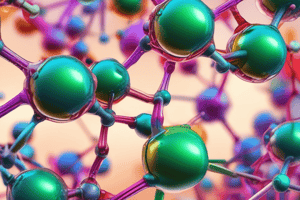Podcast
Questions and Answers
What is the difference between the basic characters of pyridine, quinoline, and isoquinoline?
What is the difference between the basic characters of pyridine, quinoline, and isoquinoline?
- All three are equally basic
- Pyridine and quinoline are basic, while isoquinoline is not basic (correct)
- Pyridine is not basic, while quinoline and isoquinoline are basic
- Pyridine and isoquinoline are basic, while quinoline is not basic
Which positions of alkyl groups in pyridine are more reactive than when attached to benzene?
Which positions of alkyl groups in pyridine are more reactive than when attached to benzene?
- 1-,4-,6- (β- and γ-alkyl)
- 1-,3-,5- (α- and γ-alkyl)
- 2-,4-,6- (α- and γ-alkyl) (correct)
- 2-,3-,5- (β- and γ-alkyl)
What is the difference between the aromatic properties of pyridine and quinoline?
What is the difference between the aromatic properties of pyridine and quinoline?
- Pyridine is not aromatic, while quinoline is aromatic
- Pyridine and quinoline are not aromatic
- Quinoline is not aromatic, while pyridine is aromatic
- Pyridine and quinoline are both aromatic (correct)
Flashcards are hidden until you start studying
Study Notes
Heterocyclic Compounds
- Pyridine, quinoline, and isoquinoline are heterocyclic compounds, but they have distinct differences in their basic characters.
Reactivity of Alkyl Groups in Pyridine
- In pyridine, the α-positions (2, 4, and 6) of alkyl groups are more reactive than when attached to benzene.
- This is due to the electron-withdrawing effect of the nitrogen atom in pyridine.
Aromatic Properties
- Pyridine and quinoline both exhibit aromatic properties, but with some differences.
- Pyridine has a higher degree of aromaticity due to the electron-donating effect of the nitrogen atom.
- Quinoline has a lower degree of aromaticity due to the presence of a benzene ring, which reduces the electron-donating effect of the nitrogen atom.
Studying That Suits You
Use AI to generate personalized quizzes and flashcards to suit your learning preferences.




